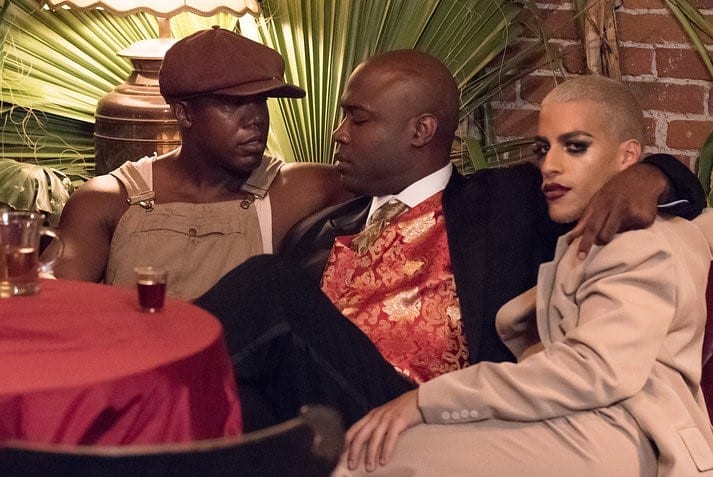Perhaps the greatest betrayal of learning history in schools is its immense erasure. Whether it’s textbooks asserting that enslaved people were “workers” or ignoring the Black artists whose sounds and aesthetics “inspired” Elvis Presley, the result is the same: We walk away with an incomplete understanding of who and what paved the way for us. That is why many people don’t know that the Harlem Renaissance—the celebrated explosion of Black culture in the early 1900s—had, at its centre, numerous LGBTQ2 creatives. The Queer Harlem Renaissance Project, a multimedia series of short films and documentaries, aims to change that.
Created by Robert Philipson, a former literature professor turned filmmaker, the Queer Harlem Renaissance Project is an initiative by Shoga Films, Philipson’s non-profit production company. Philipson says he was inspired to create the project while teaching in the early aughts. “I ran across these references and indications that many participants in the Harlem Renaissance were queer.” He decided to take this unearthed information and transpose it into moving images. He’s since directed the award-winning short doc T’Ain’t Nobody’s Bizness: Queer Blues Divas of the 1920s and produced the narrative short Congo Cabaret. His latest short film, Queer Harlem Renaissance: A Prospectus, was just released.
The 15-minute documentary serves as a proof-of-concept for what Philipson hopes will become a feature-length doc about queer folks in the Harlem Renaissance. The film surveys a number of unsung LGBTQ2 titans of the time, from writers Richard Bruce Nugent and Claude McKay to musicians Bessie Smith and Ma Rainey.
Narrated by Hamilton breakout star Daveed Diggs (“I’ve known Daveed since 1995 when his father and I became romantic partners in Oakland,” Philipson says), the short aims to position the time period as not just a moment of Black cultural formation but also of queer cultural formation. It joins the cinematic landscape explicitly reflecting the queerness of the time period, occupied most notably by Isaac Julien’s Looking for Langston (1989) and Rodney Evans’ Brother to Brother (2004).
It’s of note that Philipson is a white, queer Jewish man making Black-focused works at a time when cultural misappropriation is such a hot button issue; Philipson is no stranger to this being pointed out. He says he started every African American literature course he taught answering the question, “Can a white professor teach Black literature?” Although his answer often recognized his academic credentials, Philipson says his role was not to “provide a subjective take on Black identity but put the books we were reading in historical and race-relations context, as well as give students the critical tools necessary to read and interpret texts.”
As far as the film, he adds, “Even though I’m not Black, I have the passion, deep historical research and, now, the contacts and technical know-how to get this done. In order to make sure that other perspectives are incorporated, many of my collaborators are Black or Black and queer.”
One such associate is Khalil Sullivan, lead singer of the Oakland-based ensemble Mad Noise and guitarist for the San Francisco-based punk rock band The Truants. He serves as a producer and artist-in-residence at Shoga Films. “The Harlem Renaissance has a queer strain flowing through it because, as Black people, we are straight and queer, religious and atheist, Black and other racial identities and the list goes on and on,” Sullivan says. “We’re so many things, and yet, we have to balance the profoundly crushing weight of [anti-Blackness] and white supremacy that runs rampant in the West, if not the entire modern world.”
“We have to find space to love ourselves, celebrate our livelihood and recognize all of the beautiful aspects of our multifaceted selves,” he adds. “That desire flows through the art and literature of the Renaissance.”
Other collaborators involved in the Queer Harlem Renaissance Project are the married directing and producing duo Deondray and Quincy Gossfield, also known as The Gossfields (The DL Chronicles). They co-directed Congo Cabaret (parts of which are featured in Prospectus), as well as an adaptation of an episode in McKay’s bestselling novel Home to Harlem and the forthcoming Smoke, Lilies and Jade—a Billy Porter–narrated adaptation of Nugent’s writing dubbed the first positive depiction of same-sex love in American letters.
“Because the Harlem Renaissance is so revered and celebrated in Black culture, knowing that same-gender-loving folks were a part of that tapestry and helped shape the movement would do a lot more for Black LGBTQ inclusion and equality in the Black community,” Deondray Gossfield says. “If while growing up as a closeted gay man, often embarrassed and ashamed by my sexuality, I had known of the Bessie Smiths, Ma Raineys, Alice Dunbar Nelsons, Wallace Thurmans and the Richard Bruce Nugents of the movement, and [if] the Black community and historians had openly celebrated their contributions, I might not have been so self-deprecating and hidden.”
“Visibility is important for both LGBTQ and heterosexual people, because it combats stigma,” Quincy Gossfield adds. “In the absence of knowledge all we have is ignorance. The lives of African American LGBTQ people have been completely buried in our history and, because of that, homophobia in our community has been allowed to flourish. But we are here. We have always been here and nothing is worse because of it, only better.”


 Why you can trust Xtra
Why you can trust Xtra


